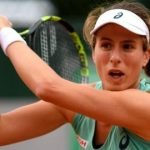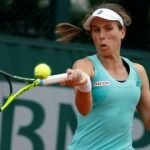Like Andre Agassi and Roger Federer, and Don Budge and Fred Perry before them, Novak Djokovic’s moment of crowning glory came on the Philippe Chatrier court.
The eighth man to have claimed all four of the sport’s Grand Slam titles has also done something that has (so far) proved beyond both Federer and Rafael Nadal. For the first time since man landed on the moon, the same player is the Wimbledon, US Open, Australian Open and now French Open champion.
Rod Laver managed to win all four in the same year for the second time in his career in 1969, and Djokovic is now dominating the game like a man who has every intention of emulating him.
“I don’t want to sound arrogant, but I really think everything is achievable in life,” he said, when asked about his chances of achieving the calendar Grand Slam.
“That’s still a possibility. But I don’t think about it right now.”
In a BBC interview, Djokovic, who beat Britain’s Andy Murray in four sets at Roland Garros, continued: “I’m privileged and honoured to be alongside Rod Laver.
“I have probably experienced one of the most beautiful moments of my professional tennis career. I would say winning Wimbledon in 2011, victory in the [2010] Davis Cup and this moment are quite remarkable and unforgettable.”
Winning an Olympic gold medal for Serbia is also very high on Djokovic’s list of priorities for the year, and if he can win the title in Rio, as well as at Wimbledon and the US Open, he will emulate Steffi Graf’s ‘Golden Slam’ of 1988.
The schedule, though, is gruelling. Wimbledon starts in three weeks’ time, the Olympics follow on four weeks later, and then – after just a fortnight’s rest – New York hosts the US Open.
But if anyone can, Novak can. He has been in the past six Grand Slam finals, and won five of them. And clay is considered his weakest surface.
Djokovic will now disappear from public view until he opens the defence of his Wimbledon title on Centre Court. There will be no warm-up events on grass for him.
| Men with most Grand Slam titles | |
|---|---|
| Roger Federer | 17 |
| Pete Sampras | 14 |
| Rafael Nadal | 14 |
| Novak Djokovic | 12 |
| Roy Emerson | 12 |
| Bjorn Borg | 11 |
| Rod Laver | 11 |
Part of his success has been the ability to know when to rest. A slightly rusty Djokovic is still more than a match over five sets for anyone who has the misfortune to be asked to play him in the first week of a Grand Slam.
His fitness levels are beyond compare. It seems a very long time ago that Roger Federer was describing his injury record as a “joke” and Andy Roddick made fun of his long list of illnesses with flippant references to bird flu and SARS.
Despite many attempts to find a solution, breathing problems had undermined the early years of Djokovic’s career. It was only after being sick in the middle of his Australian Open quarter-final with Jo-Wilfried Tsonga in 2010, that he realised he needed a fresh approach.
Test results showed he had a strong intolerance to wheat and dairy, as well as a mild sensitivity to tomatoes. So out went the wheat and out went the dairy, and his sugar intake was significantly reduced.
Djokovic says he now struggles to catch even a common cold, and given his exceptional consistency, his case for a ‘Golden Slam’ is a persuasive one.
With 12 Grand Slam titles to his name, Djokovic now sits in equal fourth place on the all-time list. He turned 29 on the opening day of the French Open and so appears to have plenty of time to catch Pete Sampras and Rafael Nadal on 14, and even Roger Federer on 17.
Federer will be 35 in August, and has not won a Grand Slam for four years. His back injury appears to have cleared up in time for his favourite few months of the year, but the evidence of last year suggests that beating Djokovic over five sets is now a bridge too far.
“At the beginning I was not glad to be part of their era,” Djokovic admitted after his victory over Murray.
“Later on I realised that in life everything happens for a reason.
“You’re put in this position with a purpose – a purpose to learn and to grow and to evolve.”
[Source BBC]







